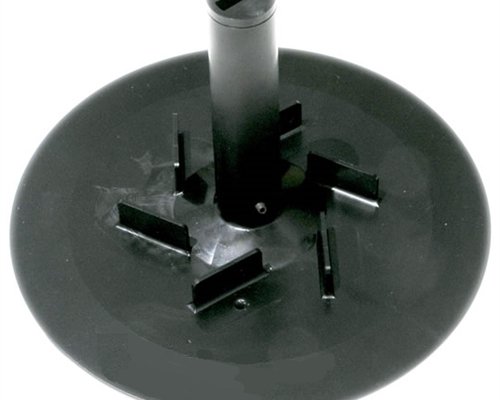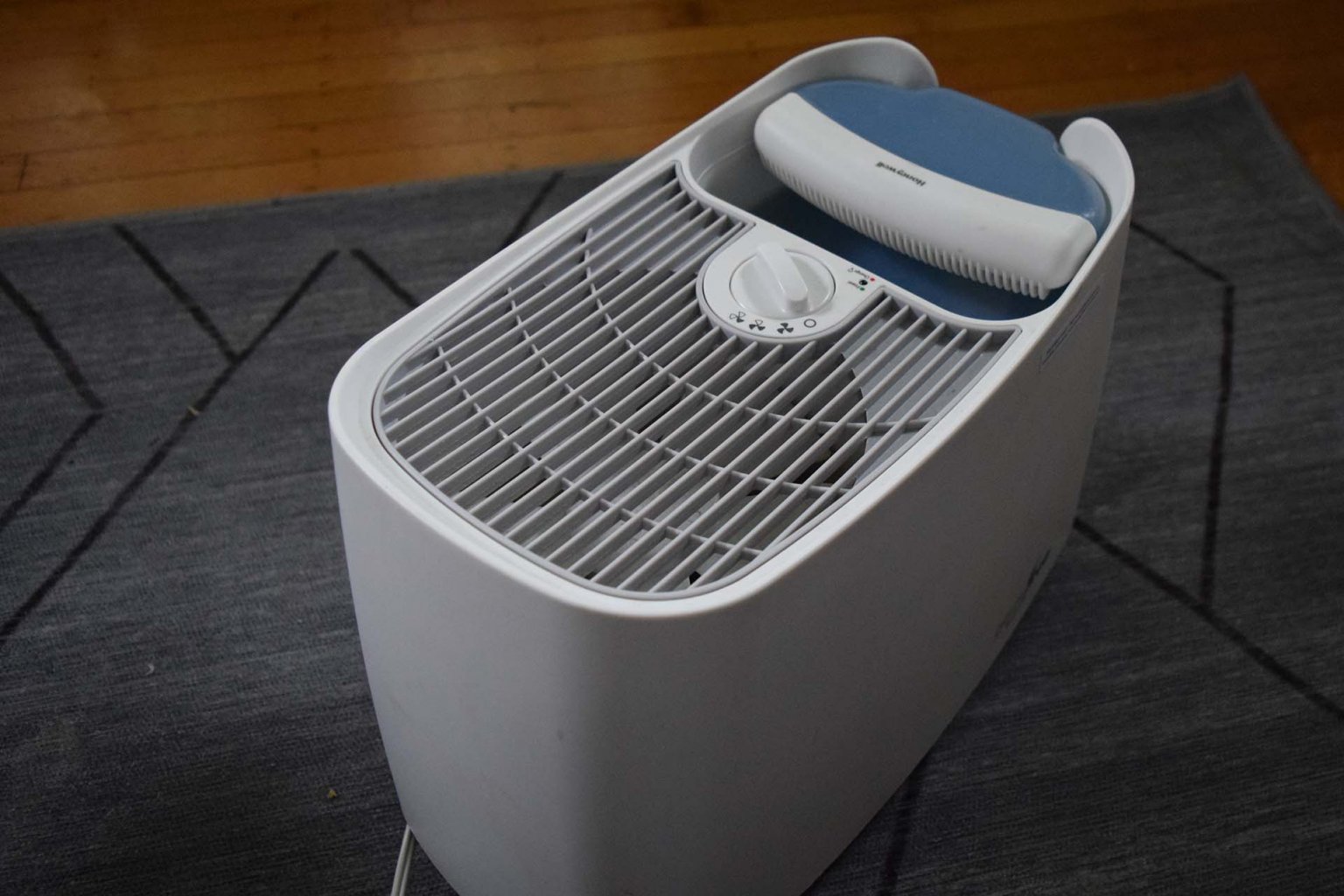If you’re suffering through dry weather, a humidifier can quench your arid home by adding some moisture into the air. Here’s how these devices work.
There are several different types of humidifiers. Whole-house humidifiers (a.k.a. central humidifiers) directly connect to your home’s air conditioning and heating unit, and are the most expensive option. You’re probably more familiar with the smaller, consumer-grade humidifiers you can buy in stores, though, which use different methods for humidifying the air.
Humidifiers are divided into two main categories: cool-mist and warm-mist. These are exactly what they sound like—if the humidifier doesn’t heat up the water, then it’s considered cool-mist. Here’s a deeper dive into each of them.
Evaporative Humidifiers Use a Fan and Wick Filter

Evaporative humidifiers are the simplest type, considering the most complex components are a fan and a wick filter. The filter is a mesh made out of cloth or paper. It acts like a sponge and soaks up water, drawing it up from the basin to the top where the fan is located. From there, the water evaporates into the air.
Technically, an evaporative humidifier could be nothing but a bowl of water sitting out on the counter, as the water will naturally evaporate anyway. The fan and wick filter simply accelerate the process to a point where you’ll actually notice a difference in the room’s humidity.
Evaporative humidifiers have the added benefit of being self-regulating, meaning that when the humidity in a room is already at a sufficient level, the evaporation process will naturally slow down, as it’s more difficult for water to evaporate in a humid environment. However, don’t confuse this with a clogged filter, as a slow-working humidifier is a symptom.
Ultrasonic Humidifiers Use a Vibrating Diaphragm to Create Tiny Droplets

Ultrasonic humidifiers are more common, and they take advantage of a ceramic diaphragm (a.k.a. piezoelectric transducer—the small, round part in the photo above) that vibrates at a very high frequency. Water particles that are sitting on top of this diaphragm aren’t able to keep up with the vibration, so air bubbles and ripple waves are formed. When the air bubbles reach the surface, tiny water droplets break the surface tension and float into the air.
EMSON Star Wars R2-D2 Ultrasonic Cool Mist Humidifier (One Gallon) Teardown
The R2-D2 humidifier is a fairly simple device…
Ultrasonic humidifiers are more energy-efficient than other types of humidifiers, making them good options if you plan on running them 24/7 and want to keep the electrical bill to a minimum. And since they don’t use fans, they’re much quieter—even the vibration is silent, since it’s at a frequency so high that human ears can’t hear it.
Impeller Humidifiers Diffuse Water Into Tiny Droplets

Impeller humidifiers work a bit differently than evaporative humidifiers. Instead of speeding up the evaporation process, impeller humidifiers use a spinning disc (called an impeller). This disc features a series of fins that carry the water from the reservoir through a mesh-like screen, which breaks up the water into tiny droplets and sends them into the air. The result is a room-temperature, fog-esque cool mist.
Impeller humidifiers aren’t as popular as evaporative and ultrasonic humidifiers, since they can’t output as much moisture. Wirecutter even skipped impeller models entirely from their recommendations, as other types of humidifiers are far superior.
Steam Humidifiers Boil Water to Slowly Release Moisture

Steam humidifiers (sometimes called steam vaporizers or warm-mist humidifiers) take advantage of a heating element that boils water, much like how a coffee maker heats up water before brewing coffee. The steam created is slowly released into the air, increasing humidity.
These are usually targeted toward those with cold or flu symptoms, as the warm moisture is great at relieving a stuffy nose and sore throat. Steam humidifiers can also heat up the room slightly, although it won’t make a significant difference.
Since the steam can naturally exit the humidifier without much help, this type of humidifier usually doesn’t have a fan. This makes it quieter to operate than other types of humidifiers, making them a good choice if you want one that’s mostly silent.
What They All Have In Common

While all of these types of humidifiers work in different ways, they do have some things in common. Mainly, they all have a gravity-fed water reservoir that holds around a gallon or so (sometimes more, sometimes less).
Secondly, some (but not all) humidifiers have an ultraviolet light on the inside that shines on the water as it passes through to kill bacteria. These are usually branded as “germ-free” humidifiers, although the boiling process in steam humidifiers naturally kills bacteria anyway.
Many humidifiers will also have filters to trap mineral deposits and sediment in the water before it makes it way through the humidifying process. The wick filter in an evaporative humidifier serves this purpose, whereas other types of humidifiers have a dedicated filter.
How to Keep Your Humidifier in Tip-Top Shape
All humidifiers require a certain level of maintenance, mostly a thorough cleaning every few days to prevent the growth of mold and other funky stuff—a UV light won’t completely get you off the hook there. This involves a quick wash with soap and water on all the critical components that are in constant contact with water. If you’re so inclined, you can also use vinegar to remove stubborn buildup, finishing up with a tiny bit of bleach for the ultimate disinfectant.
In humidifiers that have filters, the filter needs a soak and rinse with plain water every few days to clean out mineral and sediment buildup. After 2-3 months, filters need to be replaced entirely.
This kind of maintenance is extremely important, as one could develop Legionnaires’ disease or Hypersensitivity pneumonitis without the proper care.
Beyond that, you can wipe down other components with a damp towel to remove “white dust,” which is harmless minerals in the water left behind by evaporation.
Title image by YourBestDigs.com/Flickr






2 件のコメント
filters to trap mineral deposits For Ultrasonic humidifiers it’s not a mechanical filter, it’s a chemical cartridge that reacts with minerals dissolved in the water to remove them. If you have hard water you have the choice of white dust everywhere or expensive demineralizing cartridges that significantly increase the cost of running the humidifier.
Tom Smith - 返信
Wow this is really great. I’m the sort of guy that likes to know what makes everything tick just to satisfy my curiosity. I’m a fan of the show How it’s Made so i hope more articles like this one keep popping up. I was trying to justify buying the pro tech tool kit cause I already have other tool kits but I’m more inclined now to help you guys out in any way possible since this website offers so much quality information.
It would be nice to include diagrams or animations as to some of the technology works. That would bring the educational level through the roof!
lpedraja2002 - 返信